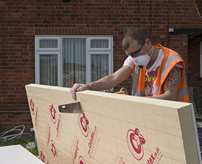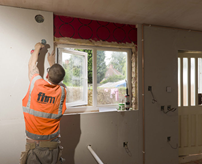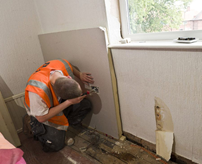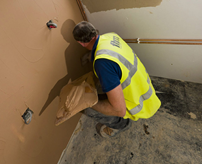Nottingham City Homes Case Study
Social housing developments began in the UK in the 19th Century and peaked in the mid-20th Century post war boom years. Now, some 50 years later and social housing is still home to more than four million UK residents, about 7% of the population. As Europe's oldest housing stock, many of these homes are insufficiently insulated and fail to meet current Building Regulations or the Decent Homes Standard. So, how can Local Authorities bring these houses up to standard in a cost-effective way?
U-value Calculator
Start your U-value calculationUsing PIR insulation for improved thermal performance in social housing
| Products Used: | Celotex PL4000 , Celotex TB4000 |
|---|---|
| Sector: | Housing |
Social housing developments began in the UK in the 19th Century and peaked in the mid-20th Century post war boom years. Now, some 50 years later and social housing is still home to more than four million UK residents, about 7% of the population. As Europe's oldest housing stock, many of these homes are insufficiently insulated and fail to meet current Building Regulations or the Decent Homes Standard. So, how can Local Authorities bring these houses up to standard in a cost-effective way?
It's time to go back to basics. In the current climate there is a great emphasis to install renewable energy technologies in order to create thermally efficient or low carbon homes. However, as with new builds, the same principles apply for refurbishment projects - a fabric first approach makes sustainability achievable. Rather than being seduced by expensive and often unproven technologies, to get the fabric of the building right will make all the difference in the long term. So, as the central Government, Local Authorities and Housing Associations search for new ways to improve the energy efficiency of the nation's underperforming buildings - the improvement of the building's fabric is crucial.
Buildings account for approximately 40% of the UK's carbon emissions and so the Government has identified improving energy efficiency in social housing as a major opportunity for cost-effective carbon reduction. The Community Energy Saving Programme (CESP) has been created to reduce the energy used for heating, lighting, ventilating and air conditioning buildings.
As part of the government's Home Energy Saving Programme, CESP has been designed to promote a 'whole house' approach to the installation of innovative energy efficiency measures, to ensure that at least 1.5 tonnes of CO² is saved per household. For existing solid wall homes, this means reducing heat losses through the building's fabric with a strong focus on the installation of high performance insulation.
Thermal efficiency in action
Nottingham City Homes, the new Arms Length Management Organisation (ALMO) that manages Nottingham City Council's rented and leasehold homes, is showing the city's commitment to improving its social housing with a multi-million pound investment. To be completed in 2015, the decent homes programme will be using this funding to massively improve thermal performance in Nottingham's 29,000 council homes.
Prior to any improvements, Nottingham City Homes (NCH) and regeneration specialist Frank Haslam Milan commissioned a trial analysis of the thermal performance of one of the city's council houses - an end terrace property in Aspley. Using the Thermal Performance Report of this house, NCH and the Nottingham Energy Partnership (NEP) came up with an energy/carbon emission improvement strategy for the two storey property - including a range of insulation products from market leader Celotex.
Thermographic images were taken before and after to see how the insulation installed improved the thermal properties of the property. The 'before' images indicated heat loss through the walls, roof and around the edging of the windows. As a result, refurbishment work included installing insulation to the external solid brick walls, window reveals and roof voids.
To provide a thermally efficient building envelope, high performance Celotex PL4000 PIR insulation was specified in thicknesses of 20mm and 65mm for installation in the buildings' solid brick walls. Bonded directly to tapered edge plasterboard, PL4000 is the ideal insulation for refurbishment projects as it offers maximum flexibility for the installer, a fast application and long term savings in both energy use and costs.
For the window reveals, Celotex supplied its TB4000 in 12mm thickness. Offering low emissivity foil facings, it is the thinnest PIR available and has been developed to eliminate the common occurrence of localised thermal bridges and greatly reduce heat loss.
A proven success
The thermographic 'after' images show that with the installation of the Celotex insulation, heat loss has been dramatically reduced in the property. Following the assessment of the trial home, there has been a programme of work developed to insulate as many as 800 council homes in the Aspley area of Nottingham, funded by Scottish and Southern Energy (SSE), through CESP.
Key considerations
When using Celotex products, you need to satisfy yourself that use of the product meets all relevant national Building Regulations and guidance as well as local, national and other applicable standards relevant for your construction or application, including requirements in relation to fire and applicable height restrictions. In addition to the product datasheet, please refer to the following product documents:
- BBA certificates - where applicable to the application
- Declarations of Performance
- Health and safety datasheets
Celotex products should not be used in the external walls of buildings over 11 metres in height. Recent changes to Building Regulations mean that only non-combustible insulation or insulation of limited combustibility should be used in buildings of that height.






